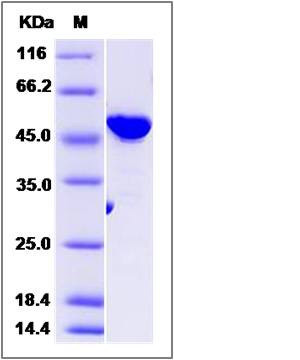Human VRK1 Protein
VRK1, PCH1
- 100ug (NPP4392) Please inquiry
| Catalog Number | P11555-HNCB |
|---|---|
| Organism Species | Human |
| Host | Baculovirus-Insect Cells |
| Synonyms | VRK1, PCH1 |
| Molecular Weight | The secreted recombinant human VRK1 consists of 398 amino acids and predicts a molecular mass of 45.6 KDa. The apparent molecular mass of the protein is approximately 47 KDa in SDS-PAGE under reducing conditions due to glycosylation. |
| predicted N | Gly |
| SDS-PAGE |  |
| Purity | > 95 % as determined by SDS-PAGE |
| Protein Construction | A DNA sequence encoding the human VRK1 ( Q99986 ) (Met 1-Lys 396) was expressed and purified with two additional amino acids (Gly & Pro ) at the N-terminus. |
| Bio-activity | Kinase activity untested |
| Research Area | Cardiovascular |Heart |Apoptosis |p53 Pathway |
| Formulation | Lyophilized from sterile 20mM Tris, 500mM NaCl, 10% glycerol, pH 7.4. 1. Normally 5 % - 8 % trehalose and mannitol are added as protectants before lyophilization. Specific concentrations are included in the hardcopy of COA. |
| Background | VRK1 is a member of the vaccinia-related kinase (VRK) family of serine/threonine protein kinases. Serine/threonine protein kinases are tumor suppressor that controls the activity of AMP-activated protein kinase family members, thereby playing a role in various processes such as cell metabolism, cell polarity, apoptosis and DNA damage response. VRK1 contains 1 protein kinase domain and localizes to the nucleus. VRK1 gene is widely expressed in human tissues and has increased expression in actively dividing cells, such as those in testis, thymus, fetal liver, and carcinomas. As a serine/threonine kinase, VRK1 phosphorylates 'Thr-18' of p53/TP53 and may thereby prevent the interaction between p53/TP53 and MDM2. Defects in VRK1 are the cause of pontocerebellar hypoplasia type 1 (PCH1), also called pontocerebellar hypoplasia with infantile spinal muscular atrophy or pontocerebellar hypoplasia with anterior horn cell disease. PCH1 is characterized by an abnormally small cerebellum and brainstem, central and peripheral motor dysfunction from birth, gliosis and anterior horn cell degeneration resembling infantile spinal muscular atrophy. |
| Reference |
